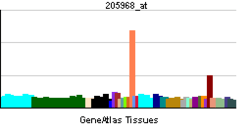KCNS3
Potassium voltage-gated channel subfamily S member 3 is a protein that in humans is encoded by the KCNS3 gene.[1][2][3]
Voltage-gated potassium channels form the largest and most diversified class of ion channels and are present in both excitable and nonexcitable cells. Their main functions are associated with the regulation of the resting membrane potential and the control of the shape and frequency of action potentials. The alpha subunits are of 2 types: those that are functional by themselves and those that are electrically silent but capable of modulating the activity of specific functional alpha subunits. The protein encoded by this gene is not functional by itself but can form heteromultimers with member 1 and with member 2 (and possibly other members) of the Shab-related subfamily of potassium voltage-gated channel proteins. This gene belongs to the S subfamily of the potassium channel family.[3]
See also
References
- ↑ Shepard AR, Rae JL (Oct 1999). "Electrically silent potassium channel subunits from human lens epithelium". Am J Physiol 277 (3 Pt 1): C412–24. PMID 10484328.
- ↑ Gutman GA, Chandy KG, Grissmer S, Lazdunski M, McKinnon D, Pardo LA, Robertson GA, Rudy B, Sanguinetti MC, Stuhmer W, Wang X (Dec 2005). "International Union of Pharmacology. LIII. Nomenclature and molecular relationships of voltage-gated potassium channels". Pharmacol Rev 57 (4): 473–508. doi:10.1124/pr.57.4.10. PMID 16382104.
- ↑ 3.0 3.1 "Entrez Gene: KCNS3 potassium voltage-gated channel, delayed-rectifier, subfamily S, member 3".
Further reading
- Maruyama K, Sugano S (1994). "Oligo-capping: a simple method to replace the cap structure of eukaryotic mRNAs with oligoribonucleotides". Gene 138 (1–2): 171–4. doi:10.1016/0378-1119(94)90802-8. PMID 8125298.
- Patel AJ, Lazdunski M, Honoré E (1998). "Kv2.1/Kv9.3, a novel ATP-dependent delayed-rectifier K+ channel in oxygen-sensitive pulmonary artery myocytes". EMBO J. 16 (22): 6615–25. doi:10.1093/emboj/16.22.6615. PMC 1170266. PMID 9362476.
- Suzuki Y; Yoshitomo-Nakagawa K; Maruyama K et al. (1997). "Construction and characterization of a full length-enriched and a 5'-end-enriched cDNA library". Gene 200 (1–2): 149–56. doi:10.1016/S0378-1119(97)00411-3. PMID 9373149.
- Stocker M, Kerschensteiner D (1998). "Cloning and tissue distribution of two new potassium channel alpha-subunits from rat brain". Biochem. Biophys. Res. Commun. 248 (3): 927–34. doi:10.1006/bbrc.1998.9072. PMID 9704029.
- Strausberg RL; Feingold EA; Grouse LH et al. (2003). "Generation and initial analysis of more than 15,000 full-length human and mouse cDNA sequences". Proc. Natl. Acad. Sci. U.S.A. 99 (26): 16899–903. doi:10.1073/pnas.242603899. PMC 139241. PMID 12477932.
- Gerhard DS; Wagner L; Feingold EA et al. (2004). "The status, quality, and expansion of the NIH full-length cDNA project: the Mammalian Gene Collection (MGC)". Genome Res. 14 (10B): 2121–7. doi:10.1101/gr.2596504. PMC 528928. PMID 15489334.
- Hao K; Niu T; Xu X et al. (2005). "Single-nucleotide polymorphisms of the KCNS3 gene are significantly associated with airway hyperresponsiveness". Hum. Genet. 116 (5): 378–83. doi:10.1007/s00439-005-1256-5. PMID 15714333.
- Kerschensteiner D, Soto F, Stocker M (2005). "Fluorescence measurements reveal stoichiometry of K+ channels formed by modulatory and delayed rectifier alpha-subunits". Proc. Natl. Acad. Sci. U.S.A. 102 (17): 6160–5. doi:10.1073/pnas.0500468102. PMC 1087924. PMID 15827117.
This article incorporates text from the United States National Library of Medicine, which is in the public domain.
| ||||||||||||||||||||||||||||||||||||||||||||||||||||||||||||||||||||||||||||||||||||||||||||||||||||||||||||||||||||||||
